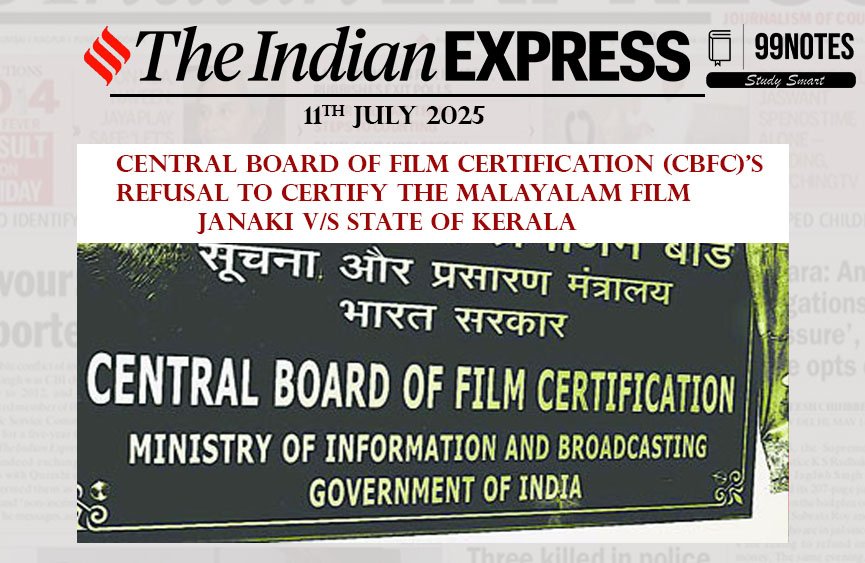11 July 2025: Indian Express Editorial Analysis
1. EC must listen
(Source: Editorial Page, The Indian Express)
| Topic: GS Paper 2 – Polity and Governance (Electoral Reforms, Constitutional Bodies) |
| Context |
|
Background of the Controversy
• The Supreme Court has not stayed the SIR process but pointed out that the list of required documents for verification is unclear and incomplete.
• The Court suggested that documents like Aadhaar, PAN card, and ration card should be accepted for voter verification to uphold the citizen’s right to vote.
• The Election Commission of India (ECI) has been accused of creating confusion by lacking procedural clarity in its approach toward the verification exercise.
Issues with the ECI’s Approach
• Lack of Legal Backing for Citizenship Test: The ECI does not have constitutional or legal authority to conduct a citizenship test, especially in the absence of a law directing such procedures.
• Arbitrary Division of Voter Data: The ECI’s separation of data into pre-2003 and post-2003 groups for scrutiny is seen as legally dubious, and has raised questions about discrimination based on arbitrary cut-off dates.
• Duplicated Deletions and Confusion: Reports from the ground show that people whose names had earlier been verified and included have found themselves re-verified or even deleted from the rolls.
Democratic Implications
• Violation of Electoral Rights: The process is likely to deny eligible citizens their right to vote, especially if they cannot provide arbitrary documents not previously required.
• Unclear Redressal Mechanisms: Citizens have little clarity on how to challenge decisions by Electoral Registration Officers (EROs), leading to confusion and loss of trust in the electoral process.
• Disproportionate Impact on the Poor and Marginalized: Those lacking standard documents (birth certificates, land titles, etc.) are the worst affected by such documentation-heavy procedures.
Supreme Court’s Role and Observations
• The Court emphasized the need for the ECI to function within the framework of justice and constitutional morality.
• It asked the ECI to clarify why documents are being taken and what legal provisions guide the exercise.
Conclusion
The current SIR process in Bihar has exposed gaps in administrative clarity and overreach in the ECI’s functioning. It underlines the pressing need for the ECI to adhere to principles of transparency, legal soundness, and citizen-centric governance in conducting electoral revisions.
Way Forward
• Issue Clear Guidelines: ECI must release comprehensive rules listing accepted documents and procedures for deletion and inclusion of names.
• Training for EROs: Electoral officers must be sensitized to avoid arbitrary removal and ensure due process is followed.
• Legislative Clarity: The Parliament should define boundaries for the ECI’s powers during electoral roll revision, especially in sensitive states.
• Improve Redressal: Set up an accessible, citizen-friendly grievance mechanism for those facing arbitrary exclusion.
| Practice Question: (GS-3 | 15 Marks | 250 Words)
The Election Commission of India (ECI) has been accused of administrative overreach during the electoral roll revision in Bihar. Examine the constitutional and legal implications of this action. Suggest reforms to ensure transparency and voter rights. |
Also Read: The Hindu Editorial Analysis- 11 July 2025
2. Trigger-happy CBFC
(Source: Editorial Page, The Indian Express)
| Topic: GS Paper 2 – Governance (Regulatory Bodies, Freedom of Speech, and Cultural Governance) GS Paper 1 – Society (Freedom of Expression, Indian Society and Art) |
| Context |
|
CBFC and the ‘Janaki’ Controversy
• The film Janaki v/s State of Kerala, based on a rape survivor’s legal struggle, was denied certification by CBFC on grounds of being “provocative and inflammatory.”
• Objections were raised over the survivor bearing a name with mythological connotations and courtroom scenes involving a character of another faith.
• A compromise was later reached after the filmmakers agreed to remove parts of the dialogue, but the incident revealed deeper systemic issues of censorship under the guise of public sensitivity.
CBFC’s Expanding Role Beyond Certification
• From Classifier to Gatekeeper: The CBFC, constitutionally tasked with certification, increasingly acts as a censor, selectively targeting films that explore uncomfortable themes.
• Political and Religious Pressures: Decisions reflect identity-based politics, often aligning with the sensitivities of dominant social, religious, or political groups.
• Erosion of Artistic Freedom: Creative voices are stifled, with CBFC decisions reinforcing self-censorship among filmmakers and altering content even before public scrutiny.
Pattern of Overreach – Recent Cases
• Films like Lipstick Under My Burkha (2016), Padmaavat (2018), and L2: Empuraan (2024) have faced similar challenges where content was modified, delayed, or censored citing potential public order threats.
• The trend reveals how certification has turned into ideological filtering – pre-empting backlash rather than respecting mature audience engagement.
Conclusion
The case of Janaki v/s State of Kerala underlines how the CBFC has evolved from a certifier to an enforcer of moral gatekeeping, compromising the fundamental right to freedom of expression. Pre-emptive censorship erodes public maturity and creative confidence, especially when done without clear legal backing.
Way Forward
• Restrict CBFC’s Role to Certification: Amend the Cinematograph Act to legally limit CBFC’s powers strictly to classification, not censorship.
• Transparent Guidelines: Develop clearer, objective certification criteria rooted in legal principles, not arbitrary morality.
• Independent Redressal Mechanism: Create an autonomous film tribunal separate from the CBFC to handle appeals and prevent conflicts of interest.
• Encourage Public Discourse: Promote a culture where mature audiences can engage with challenging cinema, rather than avoid it under the fear of mob reaction.
|
Practice Question: (GS-2 | 10 Marks | 150 Words) |
Read more – 10 July 2025 : Indian Express Editorial Analysis





